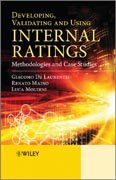
Developing, validating and using internal ratings: methodologies and case studies
Laurentis, Giacomo de
Maino, Renato
Molteni, Luca
This book looks at credit risk management, key concepts, measures and tools and focuses on possible approaches to rating, analysing and comparing expert judgment-based approaches, statistical based models and numerical tools. Two case studies are presented which focus on model building and validation. Model building is described in detail, and seeks to clarify the main issues concerned with model building, how to use statistical tools and interpret results. Univariate, bivariate and multivariate stages of model building are discussed outlining the need to merge the knowledge of quant people with that of bank practitioners. The validation case study looks a document for the internal validationunit, summarizing the process of building a shadow rating for assessing financial institutions creditworthiness is presented and analyzed. Conclusions are drawn on the use of policies in order to gain leverage on potentialities and managing limits of statistical based ratings INDICE: Preface 1 Introduction 2 Classifications and key concepts of credit risk 2.1 A classification 2.2 Key concepts 3 Rating assignment methodologies3.1 Experts based approaches 3.2 Statistical based models 3.3 Heuristic and numerical approaches 3.4 Involving qualitative information 4 Developing a statistical based rating system 4.1 The process 4.2 Setting models objectives and generating the dataset 4.3 Case study: dataset and preliminary analysis 4.4 Defining an analysis sample 4.5 Univariate and bivariate analyses 4.6 Estimating a model and assessing its discriminatory power 4.7 From scores to ratings and from ratings to probabilities of default 5 Validating rating models 5.1 Validation profiles 5.2 Roles of internal validation units 5.3 Qualitative and quantitative validation 6 Case Study. Validating PanalpBanks statistical based rating system for Financial Institutions 211 6.1 Case study objectives and context6.2 The Development report for the validation unit 6.3 The Validation report by the validation unit 7 Conclusions. Ratings usage opportunities and warnings. 7.1 Internal ratings are critical to credit risk management 7.2 Internal ratings assignment trends 7.3 Statistical based ratings and regulation: conflicting objectives? 7.4 Statistical based ratings and customers: needs and fears 7.5 Limits of statistical based ratings 7.6 Statistical based ratings and the theory of financial intermediation 7.7 Statistical based ratings usage: guidelines Bibliography Subject Index
- ISBN: 978-0-470-71149-1
- Editorial: John Wiley & Sons
- Encuadernacion: Cartoné
- Páginas: 344
- Fecha Publicación: 24/09/2010
- Nº Volúmenes: 1
- Idioma: Inglés
